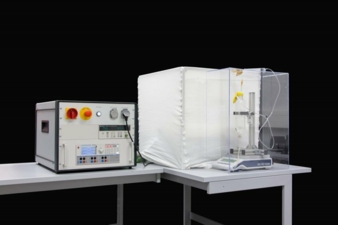26/09/2018 – DITF — auf Deutsch lesen
Introducing the heat balance measuring tool
The target? Ensuring clothing provides optimal heat exchange!
At DITF, a Heat Balance Measuring Tool (HBMT) was developed that imitates heat and humidity transfer via the human skin; this allows heat and humidity exchange to be determined experimentally.
Heat output and exchange are different during sleeping than during participation in sports. The measuring device developed at DITF is thus concerned less with testing under standard conditions, and more with reconstructing realistic physical activities and climatic conditions. Whether an item of clothing maintains the correct body temperature depends mostly on the wearer’s degree of movement. Environmental conditions such as air temperature, wind, and atmospheric humidity also come into play. The situations that nightclothes and sleeping bags need to be developed for are, thus, different from those for a sports jersey or hiking jacket.
When clothing is undergoing tested in the laboratory, it makes sense to specify the temperature of the measuring surface. When developing innovative and personalized apparel, however, defining the heat output of the measuring surface is of more significant interest. Here, the heat balance between heat generation and emission via the skin is the focus.
With the HBMT, both electrical heat output and skin temperature can be variably specified as control variables for various physical activities and maintained at a constant level for the defined environmental climate.
The measuring device’s conception is based on international norms. It consists of a measuring surface with integrated control for temperature and water supply surrounded by a base plate and frame; this prevents heat from being lost downwards and to the sides. In between are the heating elements that distribute the specified temperature evenly across the measuring surface.
The temperature of the measuring surface imitates skin temperatures and can in practice be variably specified between 22 °C (environmental temperature) and 44 °C (protein denaturation temperature).The heat balance measurements simulate near- and mid-infrared thermal radiation, gas and liquid convection or perspiration evaporation and with it all significant processes by which unclothed and clothed people exchange heat via the skin. The data to be measured are captured by sensors integrated into the base plate, frame and measuring surface and then transmitted to a central control unit.
The measuring surface of the DITF-developed HMBT may be of either a metallic or knitted construction and corresponds to the human skin concerning to critical technical dimensions such as thickness, sweat pore diameter, and sweat pore density.
Why HBMT?
Clothing has a range of functions. It has an aesthetic effect and demonstrates the social status of the wearer as well as protecting the body from the mechanical and climactic loads of the environment. Firefighters are exposed to high temperatures, flames, and hot vapors, while sports professionals in mountain environments face low temperatures, high humidity, and snowstorms. Both groups require clothing which meets the highest standards of protection and prevents potentially fatal overheating as well as burns but also hypothermia and frostbite.




